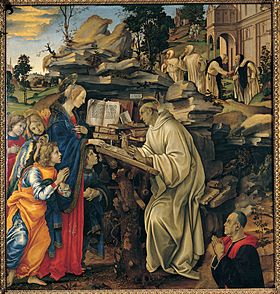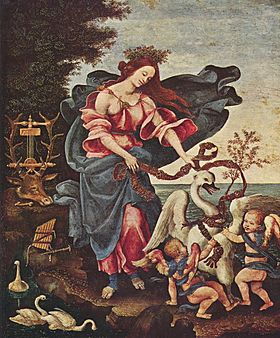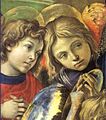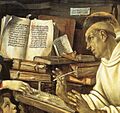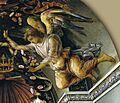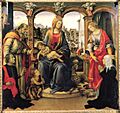Filippino Lippi facts for kids
Quick facts for kids
Filippino Lippi
|
|
|---|---|
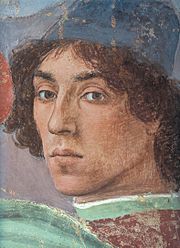
Self-portrait – detail from the Brancacci Chapel fresco The Dispute with Simon Magus (1481–1482), Santa Maria del Carmine, Florence, Italy
|
|
| Born |
Filippo Lippi
c. 15 April 1457 Prato, Republic of Florence
|
| Died | 18 April 1504 (aged 47) Florence, Republic of Florence
|
| Nationality | Italian |
| Education | Filippo Lippi |
| Known for | Painting, fresco |
|
Notable work
|
Apparition of the Virgin to St. Bernard Adoration of the Magi |
| Movement | Italian Renaissance |
Filippino Lippi (born April 1457 – died April 18, 1504) was a famous Italian painter. He worked in Florence, Italy, during the Early Renaissance and the start of the High Renaissance. His art helped shape the look of paintings in his time.
Contents
Filippino's Early Life and Training
Filippino Lippi was born in 1457 in Prato, Tuscany. He was the son of the painter Fra Filippo Lippi and Lucrezia Buti. His sister, Alessandra, was born in 1465.
Learning from His Father
Filippino began learning to paint in his father's workshop. When his father died in 1469, Filippino was only twelve years old. He helped finish the frescoes, which are wall paintings, in the Cathedral in Spoleto. These frescoes showed "Histories of the Virgin."
Training with Botticelli
After his father's death, Filippino continued his training. He became a student of Botticelli, who had also been taught by Filippino's father. Records from 1472 show that Filippino was Botticelli's only assistant. They often worked together on paintings.
For example, they collaborated on panels for large chests called cassoni. These panels are now in museums around the world. It can sometimes be hard to tell their early Madonna and Child paintings apart.
Developing His Own Style
Filippino's first solo works looked a lot like Botticelli's. Some were even thought to be by an unknown "Friend of Botticelli." But between 1480 and 1485, Filippino's style became more unique.
His early works include:
- Madonnas in Berlin, London, and Washington, D.C.
- Journeys of Tobia in Turin.
- Madonna of the Sea in Florence.
- Histories of Ester.
Important Art Projects
Filippino Lippi worked on many important art projects. He often painted for powerful families and churches.
Decorating Lorenzo de' Medici's Villa
Filippino worked with other famous painters like Perugino, Ghirlandaio, and Botticelli. They decorated the villa of Lorenzo de' Medici at Spedaletto.
In 1482, he was asked to decorate a wall in the Palazzo Vecchio in Florence. However, this project was never started.
Finishing the Brancacci Chapel Frescoes
Around 1483–84, Filippino was asked to complete a very important project. He finished the frescoes in the Brancacci Chapel in the Santa Maria del Carmine di Firenze. These paintings had been left unfinished by the artist Masaccio when he died in 1428.
In this chapel, Filippino painted scenes from the Stories of Saint Peter. These included:
- Quarrel with Simon Magus in face of Nero
- Resurrection of the Son of Teophilus
- Saint Peter Jailed
- Liberation
- Crucifixion of Saint Peter
You can see a self-portrait of Filippino at age twenty-five in the Disputation with Simon Magus fresco.
The Apparition of the Virgin to St. Bernard
Around 1485–1487, Filippino painted his most famous work. This was the altarpiece called Apparition of the Virgin to St. Bernard. It was made for Piero di Francesco del Pugliese and is now in the Badia Fiorentina, Florence.
This painting is known for its dream-like feel. It has long, graceful figures and a strange background of rocks and tree trunks that look almost human.
The Strozzi Chapel in Santa Maria Novella
In 1487, Filippo Strozzi asked Lippi to decorate his family's chapel. This was in the Santa Maria Novella church. Filippino worked on this project for a long time, finishing it in 1503, after Strozzi had died.
The frescoes in this chapel show a clash between Christianity and Paganism. This was a big topic in Florence at the time, especially with the influence of Girolamo Savonarola. Filippino showed ancient scenes with great detail. He created a mysterious and sometimes unsettling style, almost like a nightmare.
Work in Rome: The Carafa Chapel
In 1488, Lippi traveled to Rome. There, he decorated the family chapel in Santa Maria sopra Minerva for Cardinal Oliviero Carafa. These frescoes showed new ideas and his continued interest in ancient art. He finished this series by 1493.
Later Works and Legacy
Filippino returned to Florence between 1491 and 1494. He continued to create many important works.
Paintings from His Later Years
Some of his works from this period include:
- Apparition of Christ to the Virgin (c. 1493, now in Munich).
- Adoration of the Magi (1496, for the church of San Donato in Scopeto, now in the Uffizi).
- Sacrifice of Laocoön (late 1400s, for Lorenzo de' Medici's villa).
He also worked outside Florence, in Pavia and Prato. In 1501, he painted the Mystic Wedding of St. Catherine for the Basilica of San Domenico in Bologna.
His Final Work and Death
Filippino Lippi's last painting was the Deposition for the Santissima Annunziata church in Florence. He died before he could finish it.
Filippino Lippi died on April 18, 1504, when he was 47 years old. He was so well-respected that all the art workshops in Florence closed on the day of his burial to honor him.
Major Works by Filippino Lippi
- Madonna with Child, St. Anthony of Padua and a Friar (before 1480)
- The Coronation of the Virgin (c. 1480)
- Tobias and the Angel (c. 1480)
- Three Angels with Young Tobias (1485)
- Portrait of an Old Man (1485)
- Self-portrait
- Portrait of a Youth (c. 1485)
- Signoria Altarpiece (Pala degli Otto) (1486)
- Apparition of the Virgin to St. Bernard (1486)
- Annunciation with St. Thomas and Cardinal Carafa (1488–1493)
- Madonna with Child and Saints (c. 1488)
- St. Jerome (1490s)
- Apparition of Christ to the Virgin (c. 1493)
- Adoration of the Magi (1496)
- Madonna and Child with Saints (1498)
- Allegory (c. 1498)
- Allegory of Music (Erato) (c. 1500)
- Crucifixion, c. 1501
- Mystic Marriage of St. Catherine (c. 1501–1503)
- Madonna and Child, St. Stefan and St. John the Baptist (1502–1503)
- Deposition (1504, finished by Perugino in 1507)
Images for kids
-
The Coronation of the Virgin (detail) (c. 1480)
Tempera on panel, 90.2 × 223 cm, National Gallery of Art, Washington, D.C.
See also
 In Spanish: Filippino Lippi para niños
In Spanish: Filippino Lippi para niños
- Brancacci Chapel
- Carafa Chapel
- Strozzi Chapel


